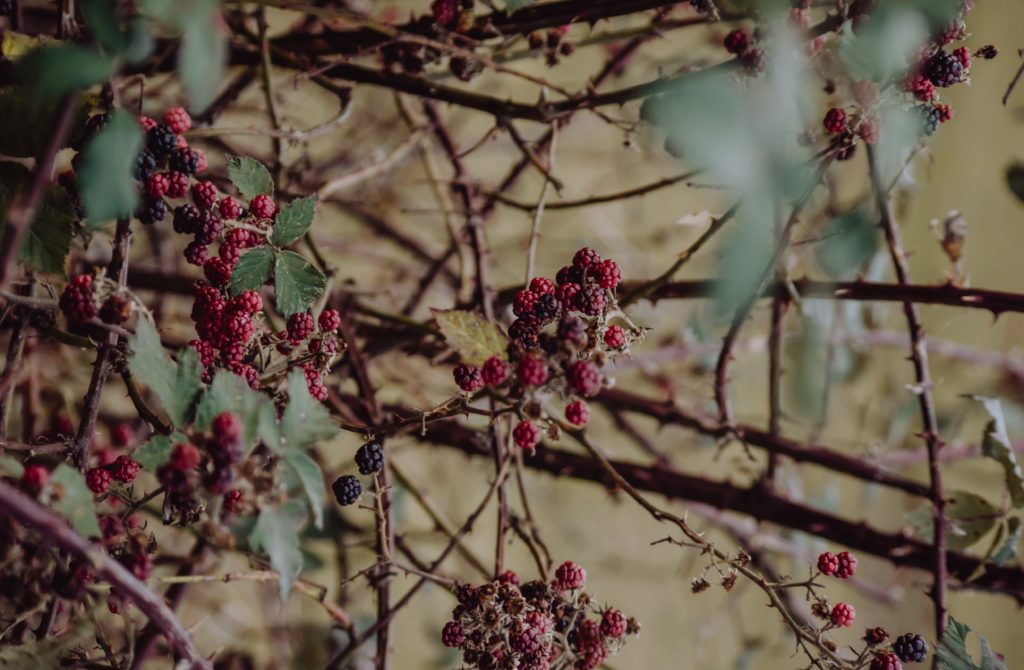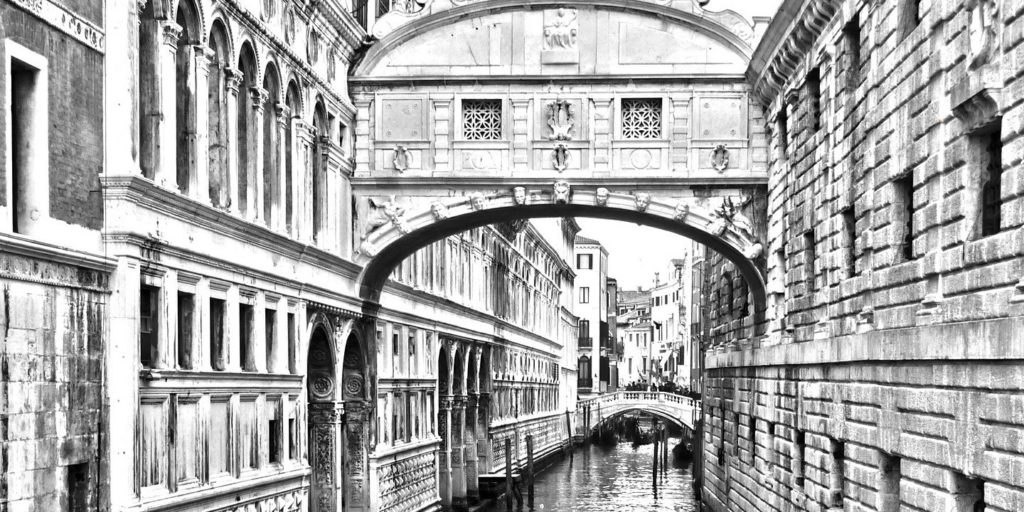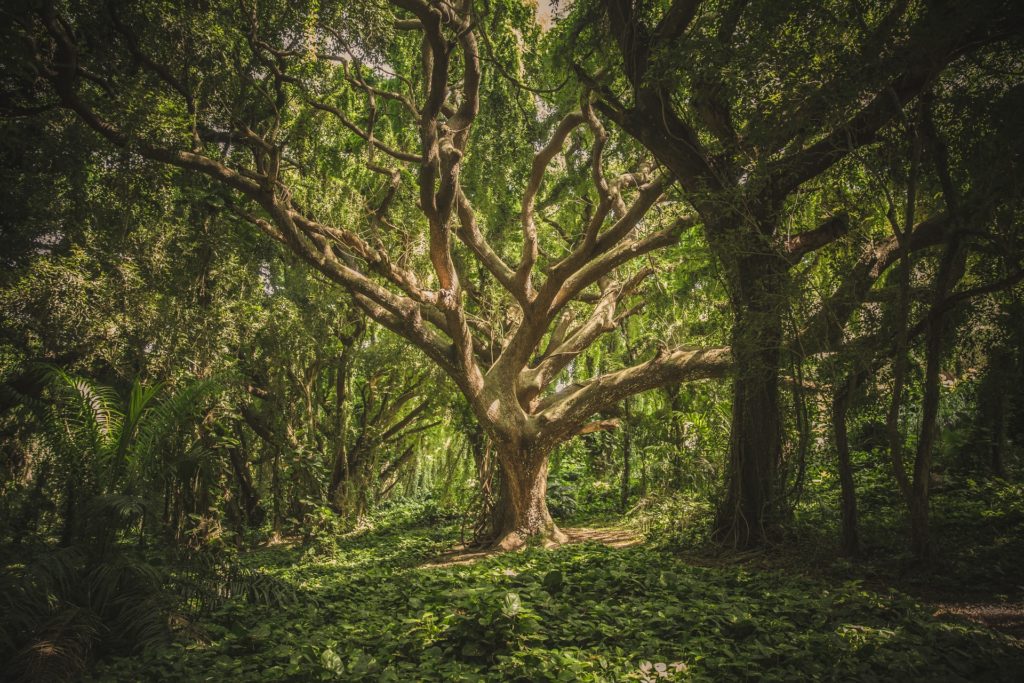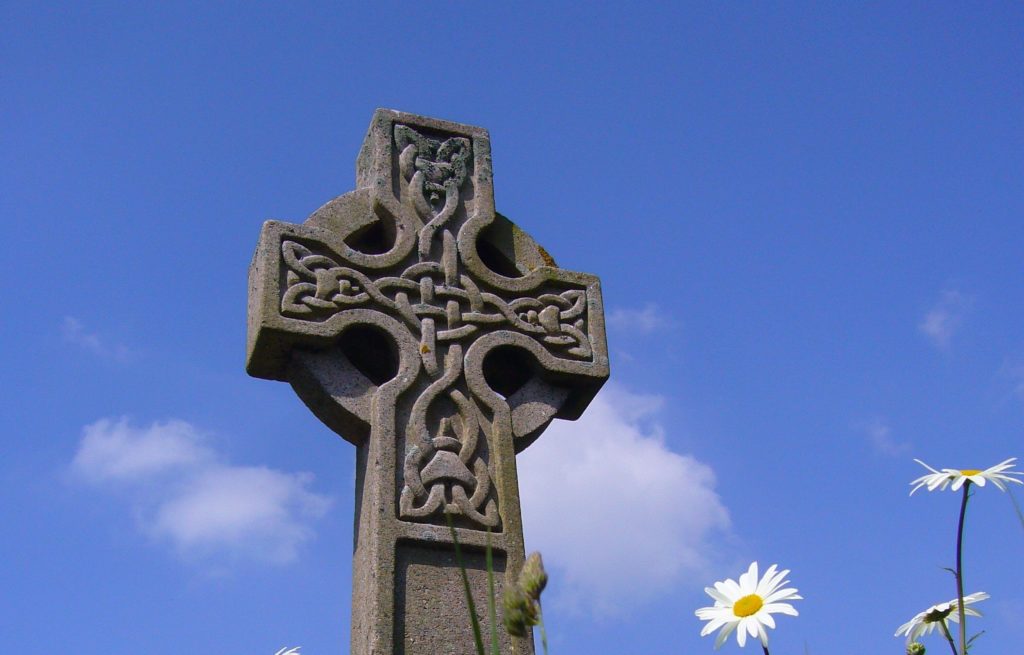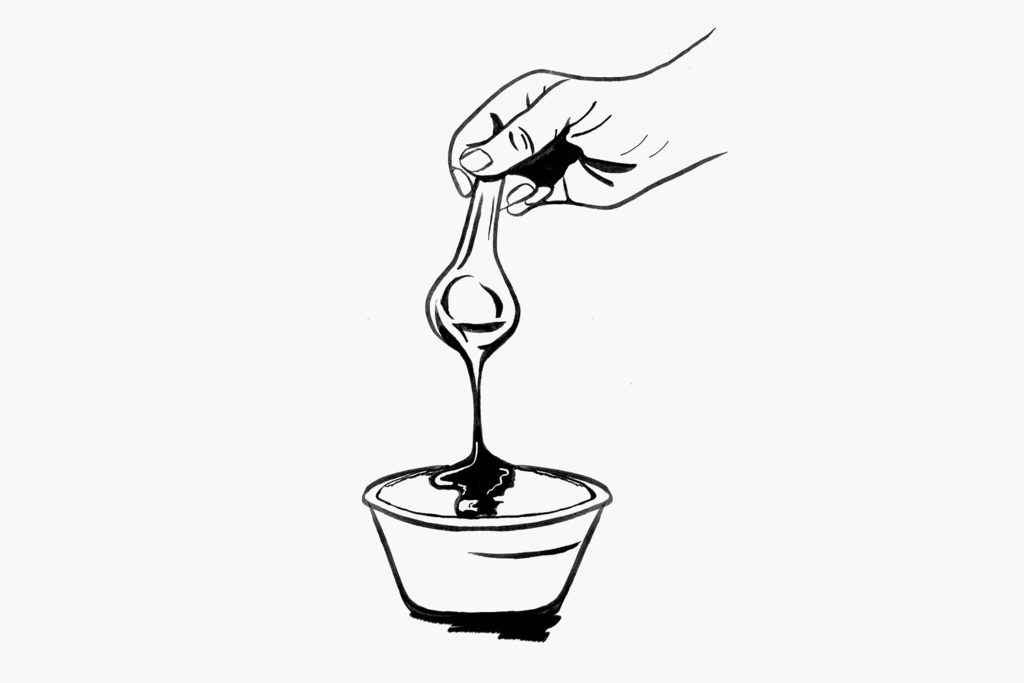The summer before I turned eighteen, I was walking my familiar route from a nearby village back into Wolverhampton, when I turned from the carriageway – a footpath-less road in the middle of nowhere, quiet apart from the occasional car barrelling along at 60 mph – onto a track separated from the road by a long, low gate and slumping piles of tires. Britain was in the middle of another heatwave, and I thought that the track might be shaded by its massed tangles of bracken, giving me a little reprieve from the mounting temperature. I was mistaken. The bramble bushes had grown ten feet high and arched together over the track, obscuring my view of the sky and the fields beyond, trapping the air beneath until it grew hot and green and close. Each breath was thick and laborious, and my skin cracked in the heat. This was the place I knew as the Old Road.
Once, the Old Road had been the major throughway between two villages. Now, it was closed off, not even named on a map. My friends and I felt we had discovered it, that it was ours – after all, we had given it a name. I walked along it every day, coming to know it intimately, to recognise the seasonal changes in the hedgerow, the way the earth smelled of warmth and dust in the summer and how the lower track churned to mud in the autumn. At dawn, pinkish light clambered just above the hedge boundaries and frost hung in the air, and it was then that one of the local farmers herded his cows down the path, changing fields for the day. Every day, I ran up the inclining track. Each twist in the road was another landmark; every track which bisected it another line to map in my head. One day, a burnt-out car appeared on the road, rusted strips of vivid orange roughly smeared across its body while it lay blackened from the inside. Cautious, we gave it a wide berth. Over time, the burnt-out car became simply another landmark, until one day it was suddenly no longer there, taken away overnight.
Get the best of Moxy directly in your inbox.
There were the remnants of a train line bisecting the road: no metal track pieces, no fence, only the scar left in the earth; a long, sunken pit demarcating the fields until it suddenly stopped short, like a steam engine slamming on the brakes and squealing to a halt. The train line seemed to slip beneath the Old Road, and then, on its opposite side, bracken grew thick and fast from spring to summer, blocking us from our explorations of the path. April, May, we spent hours hacking our way through this bracken-place with pocketknives. What should have been a simple walk took hours; we laced up our hiking boots and crammed bottles of water and bread rolls into backpacks. Once, hungry, we bought a camping stove and sat on the edge of a filled-in quarry hidden in the trees, attempting to heat bread into toast with a naked flame. We had a purpose: to learn to know the land, to trace this part of the track and understand how it lay. June, July, August, the bracken overgrew the narrowest channels and became truly impenetrable, enmeshed into a solid wall of dull leaves and hidden thorns, and we temporarily admitted defeat. August to September, the blackberries glutted, the bushes producing polished masses which we ate by the fistful, their juices staining our fingertips black.
We had learned, over time, to understand these landmarks, to understand that the scar in the ground was an old train track; that the picturesque bodies of water interspersing the fields were filled-in quarries. These places held the secrets of our industrial past. This was the birthplace of the Industrial Revolution, where coal was mined to smelt iron and steel. This was the Black Country, black by day, thick smoke billowing in the air; red by night, fire from the furnaces illuminating the sky and the clanging of machinery ringing in all directions. We could make anything, from minute nails to the chains for the Titanic.
Canals for transporting coal cleaved through our playground whichever way we turned. We often walked along them, the smell of algae baking in the heat mingled with woodsmoke and diesel emanating from the lived-in narrow boats. At the ends of some of the canals, blanketed in so much algae that they looked more like fields, hulls of old boats floated in the murk, returned to the same water which had been used as a coolant during their smelting and construction. They floated up from the depths like ancestral skeletons, until, looming just below the surface, their hollow bones stared up at us like ghostly reminders of our past. We treated the canals with care, never stood too close to the edge: my mother had instilled fear of them by telling me of her childhood friends who had drowned there, caught on those same spectres of sunken boats. My friends and I once cycled along one of the canals as far as we could, extending the furthest reaches of our map, until we came to a place where the motorway crossed over our heads, its dull rumbling moving through the base of our spines, and we watched diggers and steam rollers trawl across the rolling ground in front of us, building a new factory. Here, not every aspect of the Industrial Revolution was dead: the canals which had been its arteries had led us, once again, to industry.
The land we played in and explored was scarred with the pockmarks of this memory. Our Old Road had once been the main road connecting quarries to villages, farms, and the city. When I walked down it on the way back from the village, I imagined myself as one of the women who had lived one hundred years or more before me. Our feet drummed the same pattern over and over, and together we carved a gentle slope into the earth, forming a kind of industrial holloway. We were surrounded by relics of track and machinery hidden just beneath the earth, tinging the soil ochre with rust. The bracken we had taken blackberries from was a weed thriving at the margins of society, the places whose names had been forgotten until we came and named them by description: High Hill overlooking a mining facility, Quarry Bank where the cows grazed next to a water-filled quarry, the Train Tracks. The undergrowth folded into and around these places, reaching out to carpet the earth and forming gently undulating mounds that disguised and hid the roiled, used earth below. Dandelions and creeping cinquefoil pushed the tarmac of the Old Road apart; something so solid broken by a weed. We became familiar with places long ignored.
We waited until winter before resuming our mission to carve our way through the train line path. The lowest part of the train track, where it seemingly slipped under the Old Road and dipped into the ground, filled with groundwater rising up to meet rain. It froze over and we pitched bricks into the air, watching as they gathered speed and then slowed, forming graceful arcs as they plummeted back down to the ice. We liked to see the ice break, cracking into thick, hefty, strangely shaped panes. When we followed the track on its slight upward incline towards the bracken-place, we found that the bracken had died back and the path forwards had miraculously opened, inviting us in. We slipped through its length with ease and the land beyond revealed itself. We were on the Monarch’s Way.
∆
Over this part of the Monarch’s Way, pylons stood tall in stately, neat lines, stretching away from us in all directions. The closer to them we came, the louder their humming grew, until we felt their vibrations in our chests as we stood directly beneath them. Their stark, steel articulations glinting in the sunlight were a far cry from the origin of the Monarch’s Way, which marked the route King Charles II took as he fled the Battle of Worcester in 1651, reaching safety in Normandy after six weeks.
Around us, the odd bluebottle fly moseyed and meandered, drifting up and down aimlessly in the breeze. We stood at the crest of this route, the land dipping down dramatically to either side. To our right, it swooped suddenly back up, with cows ambling over the fields in the fading pink light and the slight stench of manure drifting over to us. Beyond the cows, we could see the Old Road, cutting through the fields on a diagonal. Together, the Old Road, the bracken-path, and the Monarch’s Way formed a triangle. Our explorations had allowed me to mark another solid point on the map in our head, and we took comfort from the presence, once again, of our known territory.
Abandoning what we knew, we chose to explore left, following the slope of the Monarch’s Way down into a labyrinthine wood. The wood was formed not of the side-lined weeds we knew, but real trees, taller, older. One was hollowed out by age or lightning strike. This section of the Monarch’s Way zig-zagged around the north-western edge of Wolverhampton, the only part of Wolverhampton which truly belonged to the Black Country, situated over the slumbering coal seam. This part of the Way connected our bracken-place to the nearby National Trust property of Moseley Old Hall. Here, the Catholic Charles II, who had stood at over six foot, unusually tall for the time, had folded himself into a tiny priest hole hidden between ceiling and floor, accessed by a concealed door leading to a gap between walls. He had held his breath as the Parliamentarians of Oliver Cromwell confronted his safekeepers outside the house. As we followed the slope down, we moved from the industrial heritage we felt we understood to an older past. Moseley Old Hall had stood stalwart since around 1600. As its neighbouring houses had transformed and the land around it moved like jigsaw pieces as field boundaries changed and roads were constructed, it had silently watched, unblinking. The only testament to the passage of time was its brick exterior, a marker of the Victorian era, when its owners transformed their wood and thatch house to resemble a kiln.
Eventually, I came to work at Moseley Old Hall, caring for the house and its contents: the carpets were hoovered and the surfaces dusted every day to ensure no insects could make their home there; measurements were taken of humidity levels, temperature, and light and UV levels. Outside, I continued to explore, discovering Berry Brook carving its shallow path through the nearby bluebell woods. In the winter, the brook swelled, water rushing across the mud to widen and deepen its path. Whilst the land around us changed, the house and its contents remained the same, a quiet and stately sense of order. The old building was forever holding its breath, waiting, waiting, for when those who had decided to preserve it would abandon it to the wild, allow it to become just another abandoned playground for children.
One day, we had a visit from the local fire service, to discuss how the house and its contents could burn to the ground in minutes without proper precautions (black by day, thick smoke billowing in the air; red by night, flames illuminating the sky and the faces of onlookers bathed in glowing heat). We were made to reckon with its possible demise, but fought to ensure it would never come. One special moment in the house’s history had been chosen to be preserved in perpetuity, a whole team tirelessly monitoring and measuring and adjusting so a perfect environment was maintained for that preservation. The passage of four centuries had been shrunk away and the potential for a different future side-lined. In between discussing how we might save the most precious items in the property, if we could at all, one of the younger firemen talked avidly about his weekend golf game, miming his swing for the benefit of his colleagues.
∆
Leaving the property that day, I walked home along Berry Brook and took comfort in the lush greenery carpeting the spongey ground, the ivy wrapped around fallen trees lying at angles across the water; a miniature river, changing day to day, season to season, like the rest of the turbid land of the Black Country.
In the Black Country, coal has long fallen out of favour and the markers of our old livelihood have been abandoned. Poverty was always present here, but now it has reached long fingers out to crush buildings into dust and twist russet rail tracks into the churned mud below. Our industrial past, all the things we had been told to build that would last forever as testaments to human ingenuity, have returned to the land. Unlike the stately Mosely Old Hall, the only remains of our more recent past were the scars on the surface of the ground hinting at what lay below and our enduring working-class community.
The forgotten past became a playground for children like me, our footsteps making no permanent mark on the land as we ran through the woods and bracken and along the tracks. We were just passing through. Abandonment formed us, the earth moulding us into people as if out of wet clay. While cold, wet, hungry, covered in blisters and peppered with nettle stings, our skin criss-crossed with bracken scratches, we revelled in the solitude of being miles from home, caught between fields, able to distantly hear the motorway and the lowing of cows carried on the wind. The land around us was an unceasing continuum, constantly changing, evolving, taking on new forms, sweeping us along with it. We belonged to the muck and poverty and freedom of the abandoned Black Country land.

